Joy E. Rancatore's Blog, page 6
October 9, 2019
Making the Most of Goodreads As a Reader
Goodreads brings together readers around the world in a massive online book club that never sleeps.
It’s amazing!
Goodreads has been my favorite social place online since I joined in 2010. Earlier this year, I wrote a post about How to Make the Most of Goodreads for authors, and I decided it was high time I write one geared toward readers!
So, are you on Goodreads? If you are, are you making the most of Goodreads as a reader? Today, let’s check out a few ways you can interact on the site and some of the benefits of being an involved reader member of the Goodreads community.
If you’re not, maybe this post will entice you to join! It’s completely free without all the pressure or negativity of regular social media.
Did I mention the books?
Let’s get you making the most of Goodreads as a reader!
Recommendations
As a Goodreads member, get ready for recommendation-palooza! Between your friends and Goodreads-generated recommendations based on your reading habits, you will never have to ask, “What should I read next?” You will ask instead, “Which one should I read next?”
I have read books I never would have discovered without recommendations received on Goodreads. Just like getting book recommendations from friends face to face, I love getting these suggestions online from reader friends I know I can trust. You can see what your friends are reading and get a feel for their tastes, which makes it easier to know whether or not you’ll like their recommendations.
While Goodreads utilizes many algorithms and probably has some promotion system in place for certain books, the recommendations I get from them are typically ones I wouldn’t get otherwise and genuinely relate to my recent high-starred reads.
Plus, I can search through any of their many categories to look for something more specific to my tastes. You can even go through their recommendations and select “not interested” to help better tailor them to your exact interests.
Relationships
What better way to keep up with friends all over the world than by what they’re reading? When you engage in conversation around a piece of literature, your communication will be deeper and more revealing of each other’s character, philosophies and passions. That could then lead to an even deeper relationship.
Reviews
It’s no secret I’m a huge fan of reviews. I shared a three-part series on the importance of writing KINND reviews. Book reviews help authors, publishers, agents and others in the industry; but they also aid readers.
Think about the last time you were choosing between two books to read. What helped you make that decision? My guess is a trusted friend’s recommendation may have come into play somehow. Past that, maybe you were in a bookstore or online reading and rereading the book’s description.
If you had hundreds of reviews to glance through in the palm of your hand, would that have helped? With Goodreads, you do! You can pull up any book and see reactions from your friends or from the community in general. You can pick from 5-star, 3-star and 1-star reviews to get a well-rounded picture.
Of course, that only works when readers leave reviews in the first place! That’s where we come in. As readers, we have an opportunity to leave our reactions and thoughts on books for others like us who may be trying to decide which book to give their next block of reading time to.
As I mentioned in my first post on KINND reviews, writing reviews helps readers keep track of the books they’ve read and remember what they did or did not like about those books. It’s also a way for you to become part of the great literary conversation across time and space as readers and authors come together to discuss books.
Finally, I think it’s a helpful mind exercise. Instead of mindlessly reading, you’re reading with purpose, paying close attention to details in the narrative with the goal of sharing the highs, lows and in-betweens.
Recreation
Goodreads is not without its entertainment value. You can join various groups, participate in literary polls, commit to a yearly reading challenge (and cheer friends on with theirs), enter giveaways for great books and be a voice in the annual Goodreads Choice Awards.
Reach
Finally, never before have readers had more of an opportunity to reach out and touch authors. Thanks to Goodreads, you can follow your favorite authors to get updates when they release new books or give one away. You can ask them questions—that they’re likely to answer—and receive weekly roundup emails with blog posts written by all the authors you follow. Keeping those all in one email sure is handy!
Plus, because authors are first and foremost readers, you’ll get to see what your favorite writers read. You might have some common favorites!
If you’d like to start with an author you already know, give my author profile a follow today and ask me a question. I recently answered a couple, so those might spark your curiosity and inspire your own questions!
I’ll see you on Goodreads!
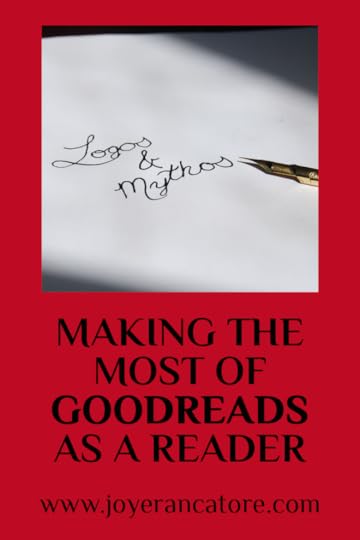
Are you on Goodreads already? What are some of your favorite things there? Have you interacted with your favorite authors?
If you’re not on Goodreads, what questions do you have about it? Would you like to join? What’s held you back so far?
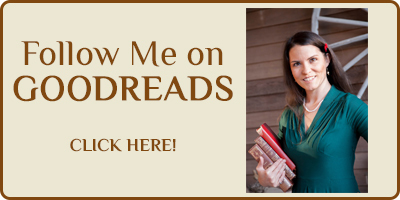
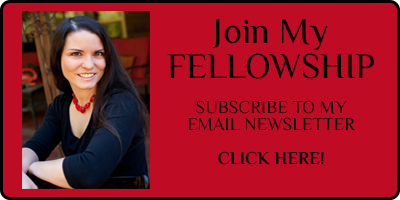
FollowFollowFollowFollowFollow
The post Making the Most of Goodreads As a Reader appeared first on Joy E. Rancatore.
October 2, 2019
Indie Authors and the Case of Fifty Hats
Working as an Indie Author is a little like attempting to switch hats during a storm with hurricane-force winds while still holding on to the other forty-eight hats in your collection.
Yeah.
As in a prized hat collection, each of our metaphorical ones has a place and a purpose and a reason for belonging. We may or may not be able to rid ourselves of some of these hats, but we’ll still have to juggle at least part of them. We should probably figure out a better way to do that.
Naming All the Hats
In a previous post, I shared most of my many “hats” of Indie publishing. Orna Ross—one of the inspirational Indies I’ve looked up to and learned from on my journey—has a great system, where she separates tasks under the titles “maker, manager, marketer.” Check out her Go Creative! series for more details.
Here’s how I envision my hat collection based on her model. They all fall into one of three styles—the comfy beanie (maker), the jaunty trilby (manager) and the stylish cloche hat (marketer). Within those three styles, you’ve got a plethora of colors to choose from, which then represent the various tasks under each role.
One of the most important things for Indie Authors to do is to write these out, think them through and evaluate when each one is needed. It’s especially vital to understand when you need to don a manager hat over a maker one. Each requires a unique mindset and focus.
Understanding the vast difference in approaching publication decisions, such as trim sizes and formats, between a publisher’s perspective—Which option is most fiscally responsible and likely to sell?—and an author’s—But, I want a hardcover book with my name on it, and this size feels better in my hand!—enables you to be a better entrepreneur and probably a more successful one.
Sorting and Reducing the Hats
Look through your list and cull out any that really aren’t necessary to your business at the moment or aren’t providing you a ROI worth the time or expense to produce it. Next, determine if you can outsource any still on the list.
Remember, time is money. Weigh your time versus the financial cost to outsource a task. If it takes you twelve hours to run your social media each week, but you can pay someone to do it in five hours, will that then free you up to be more productive in other areas; therefore, saving you money in the end?
Claiming Your Hats
Once you’ve carefully and thoroughly considered each of your hats, claim the ones that are left. These are your roles and responsibilities as an Indie. Embrace each one and determine how you can best juggle them.
This is where your individual needs and goals and priorities will drive your next steps. Each of us will handle this in a different way. Honestly, this is also a process that will need constant reevaluation. Your focus and needs will shift, and you must be able to move with them.
It’s much like having a young child. They function best on schedules; the only problem with that is their sleeping and eating needs change often as they grow. With those alterations in their days come schedules thrown out with the trash and frustration until a new one is established. Trust me, it’s one of the most trying parts of parenting infants and young children. Just as soon as you think you’ve got this parenting thing and you might survive after all, the schedule whizzes past you and you’re left grasping for some semblance of order to get you all back on the same page.
With my second child, at least I knew to expect the frequent schedule changes. That made adjusting so much easier because it took away the frustration of facing something unexpected. Instead of wasting what little brain power I had on bemoaning this new form of torture from the small being in my care, I went straight toward finding a new schedule that worked for him.
Consider this your warning, Indie friend. You now know the changes will come, the priorities will shift and new roles will develop. Now, instead of being sideswiped by flying schedules and roles, you can duck and come up with a new plan of action.
You’re welcome.
Will-be parents, you’re also welcome.
Ordering All the Hats
Okay, so we’ve established that some order of operations is required to juggle all these roles. But, how?
As I’ve already said, this will be unique to your situation and you will have to determine what that is. But—don’t worry, I’m not leaving you there!—I can share with you what I’m doing (or have done) and plan to do.
First, you will always wear all your hats in some regards. What I mean by that is, you cannot leave your publisher hat at home when you go on a writing retreat with friends and brainstorm a million great ideas and agree to do them ALL. Publisher you and author you will have a royal smackdown when you get home.
At the same time, you need to properly identify the primary hat needed for each task and carefully store the others away in their proper places, all while still keeping them nearby. Storage keeps them from getting swept away in the wind gusts; nearby allows you to pull them out when a sudden opportunity presents itself or an issue arises that requires a different perspective to handle.
Time-blocking
Now, I’ve written before how I like to time block. In a perfect world, I would have a full two to four hours to devote to each task. In reality, this means that I take the thirty minutes between when I finish teaching my children and set them loose with their independent work and when they finish it—or have a royal meltdown because they can’t find the pencils and erasers and paper they drop all over our house like odd and unnecessary breadcrumbs—to type the first draft of this week’s blog post.
Sometimes I’m able to pre-schedule my blocks:
1:00 to 2:00: draft a client’s post
2:00 to 2:30: catch up on social media and check and send emails
2:30 to 3:00: write next week’s podcast shownotes and make a planning list for the nonfiction revisions
3:00 to 4:00: prepare for this week’s book signing events
4:00 to 4:30: edit two blog posts
4:30 to 5:00: update graphics, catch up on social media and emails
Other times it’s more like the previous paragraph where I have a few minutes, look at my to-do list (more on that in a moment) and choose the one that’s either highest priority or can be done in the time frame or in the place where I happen to be.
And still others, like today, I plan my blocks and school runs long. So, I take out my trusty list, re-prioritize and do the most pressing tasks first because I’ve lost 1:00 to 3:30 and I have to leave at 5:15 for a meeting.
Daily Focus
Another trick I plan to utilize more is to focus on certain hats on certain days. If I can don my editing cap three days a week, author beanie two days and publisher’s derby two days instead of switching between all three every day, perhaps I will be a more focused worker with higher quality production.
This same concept can be shifted to be weekly or monthly or even quarterly. I have been trying to get myself on a system where I do all my blogging for the month in one week. I haven’t quite achieved that yet; however, it’s still on my radar and it’s something I think would work well for me. I have taken some small steps toward making this happen and hope to implement it for a trial run either at the end of this year or beginning of next.
My first step was streamlining and planning my blog topics. Having specific topics to write about and post each week enables me to plan ahead better. And that, in turn, should give me the ability to write them all (or most) at once.
Lists—Made and Checked
I’m not one to say “you MUST do” or “the BEST way” or “if you don’t do this, you’re CRAZY;” however, if you’re not making lists, you honestly might be doing yourself a disservice. If you don’t have some system in place to keep up with all you have to do, chances are high you will overlook something.
As I make my list, I check it twice … with my hats in mind! Just as it’s important to recognize each of the hats in our collection to begin with, we can help ourselves by identifying what task requires which style. That will aid with determining how to alternate them.
Let’s say you have two short stories and a blog post to edit and then prepare to promote. It might be easier to create all your graphics in one go and then save editing for another time block. Or, for you, it might be easier to switch back and forth—edit, then let your mind rest and create, then edit the next, then produce something creative again and so forth. Either way, you’ll save time splitting your tasks when you have your list made and ordered according to your focus for each.
Embracing All the Hats
At the end of the day, you chose to be an author. That choice—regardless of publication method—comes with far more responsibility than just writing. For that reason, you’ll need to embrace every hat in your closet and work through how you can best alternate them.

What does this process look like for you? What tips do you have for ordering the hats in your writing life?
Not a writer? I bet you’re juggling hats, too! Tell me about it and share your tips for keeping it all going.

FollowFollowFollowFollowFollow
The post Indie Authors and the Case of Fifty Hats appeared first on Joy E. Rancatore.
September 26, 2019
Lessons from Publishing My Debut Novel
Tuesday marked the beginning of a new chapter in my life—the publication of my first novel. While, in many ways, this has been just another week—each day full of the typical weekly activities and responsibilities (times a thousand, thanks to all the last-minute tasks and preparations of getting my book info out wherever I can)—it’s also been full of the realization of a dream come true and the hopes of so many more to come.
As I type this (at midnight on my blog post day), I’m reflecting on five lessons from publishing my debut novel.
Fear lies around the corner at every step.
The monsters of Fear and Doubt don’t stop when you pick up the pen and write until you reach The End. They emerge frequently during revisions and editing. They grow larger than life when it comes time to approve proofs and hit publish. And, once your words are out in the world to be judged, critiqued and criticized, they box you into a corner and loom over you until you shrink down and withdraw deep within yourself.
But, just as with each step you’ve already achieved, once more you can find a hidden reserve of courage, of confidence and of determination—each of which combines to strengthen the resolve to stand. Stand in the face of these monsters, grow larger and confront them face to face and say, “Not today. Today, I am a published author. Today, my words blow on the winds of readers’ excitement. Today, I launch my literary legacy; and, today, I choose to push past you to enjoy the moment and look ahead to my next task, my next story, my next contribution to the great ongoing conversation that spans millennia and includes great thinkers, common folks and people who sparked revolutions.
My biggest fear lies not in the words of the critics.
When you think of Fear and Doubt as a writer, it primarily lands on our abilities and others’ perceptions of those abilities. My biggest fear now that my work is out finds its roots elsewhere.
Today I feel like I hold the hopes and faith of every person who has supported me through this process. When I think through that long list, I’m humbled, thankful, awed; but I’m also fearful. What if my words disappoint? What if I fail? What if …
I know. That question only works well when brainstorming a novel.
This past Sunday, my book’s launch was mentioned along with the other announcements because I have the most supportive church family on the planet. Seriously, we’re having a Chicken ‘n’ Dumplin‘ CookOff next Sunday just so I can find a recipe to use with a giveaway for book events. I can’t tell you how many times members of our congregation have come up to me and asked when they can buy my book. It’s just incredible and beyond my wildest imagination!
It’s not just my church community, though. From my loving family and friends to all my local libraries to my local bookstore and several other fantastic independent bookstores in the South to YOU … I am being carried on strong shoulders!
The thought of disappointing you all terrifies me.
I love this book, but I’ve got the capacity to love the next too.
Once you’ve had a child and consider having another, you feel a nagging prickle of fear that you couldn’t possibly love another human as much as you love that first little bundle. However great that fear grows as the little person develops and prepares to face this world, one look at him or her and you know—your capacity to love runs deep, and that first moment of eye contact seals the deal.
I will always love Jack’s story, but—in some ways—it’s no longer mine. It now belongs to the readers. My responsibility lies with my next story now; in giving it shape and being and purpose. Any Good Thing got all it needed from me to be a fully grown literary citizen, ready for the world. It’s time for me to pour that into a new work.
Instead of wanting to cling to it or not wanting to move on from it, I find myself proud of it from a distance and eager to continue with the next projects already in the works, with the ever-growing vision of the next new project already bubbling in my imagination and longing to be birthed.
This is only the beginning.
I want to soak in every moment of this beautiful first, but I’m highly mindful of the fact that this is only the first of … what I hope will be … many stories. My focus fluctuates between worrying I’m going to mess up this first one to thinking ahead to the next.
Patience continues to be a lesson cast upon me.
Have you ever heard the saying about how every overnight sensation took decades to become one? Nowhere is that more true than with authors—though, we may never be considered a “sensation.” In fact, very few will ever make a living from their books alone.
As I check my sales reports, I have to remind myself of these facts and logically contemplate how it will take time to find my readers. It will take steps—some small, some better titled “leaps”—and many of them to get me to a place of seeing tangible results.
But, every opportunity—like teaching the college class tonight, that I was asked to do two days ago—and interaction—like finding the nerve last year to ask the bookstore owner at the Mississippi Book Fest if she ever considered self-published authors—bring me closer to the goals I’ve set for myself in this career and to the results I desire from this endeavor.
My desire is that these lessons from publishing my debut novel will inspire and encourage you and that they will remind me of where I’ve been and push me harder toward pursuing the many goals I’ve set for myself and my future.
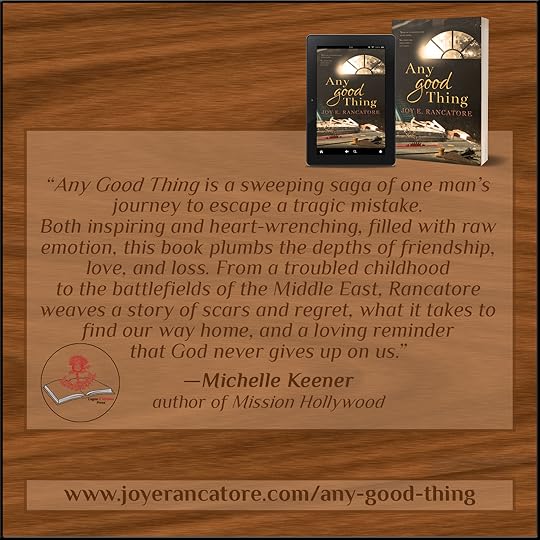
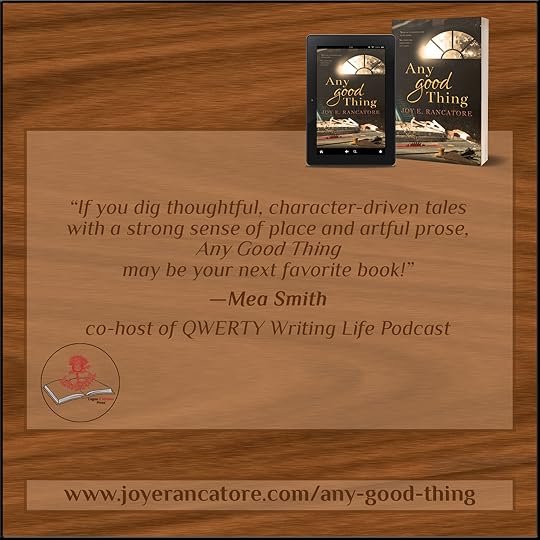
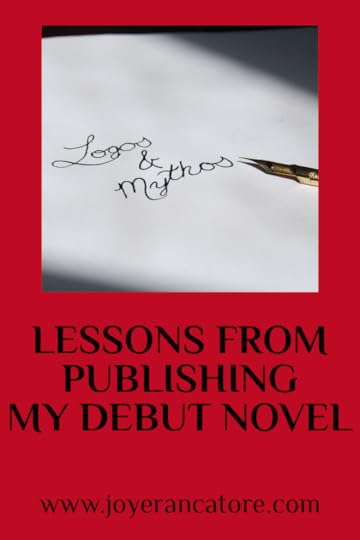
If you’re a writer who is published, what were some of the lessons you learned from that first one? How did those lessons steer and motivate you toward your next publication and all the ones that followed?
If you’re working toward publication, what questions do you have? Do you have some concerns or fears about it?
As a reader, what do you think about this crazy process of publishing? Do you have questions about how I’ve gotten to this point or where I intend to go?
CHALLENGE: Did you know you can have Any Good Thing in your local independent bookstore or library? That’s right! All you have to do is let them know and put in an order (store) or a request (library). Your local bookstore can order any book with an ISBN (the special number assigned to a book). Most libraries welcome requests from their patrons. If you would like to do this, please email me because I have a sheet all ready for you with all of the information (including ISBNs) they will need from you. I’m also willing to do in-person book signings and can do in-person or virtual book readings or talks about the facts behind my fiction. These options could also extend to book clubs who choose to read my book together. For more information on booking me, please contact Logos & Mythos Press!

FollowFollowFollowFollowFollow
The post Lessons from Publishing My Debut Novel appeared first on Joy E. Rancatore.
September 18, 2019
Shield of White and Fur
This story continues a series of short fiction exploring some of the Faerie Shepherds and Shepherdesses within my fantasy world. Read below the story for further explanation and head over to the Tales of the Faerie Shepherds if you’d like to read more!
The winds blew a disturbance through my fur. Nose raised, I twitched, inhaled; inhaled, twitched. Uncertainty. Fear. Distress. The scents swirled as they flooded my nostrils.
Another redolence encased the others. This one raised the hairs of my neck. I’d sniffed it far too often.
Evil.
The fears around were caused by no mere fae seeking nursemaids for their young. These terrors blackened as I inhaled deeper. Lives hung in the balance. Maelphaeus and his daemons roved, unchecked.
Except …
The One had come. Her training had been completed. She was ready, and yet …
I rose on all fours, my nose searching harder, further. She was weak. Afflicted. Her scent carried great agony of spirit.
Stretching forward, my great paws sank into the damp moor beneath me as I readied my legs for their fastest speed. Returning to my previous stance, I sniffed once more, judging distance and terrain. Now ready, I shook my shaggy white fur. Once, I had mourned its shade. Dark green was the color I should have been. White wasn’t ominous or muted enough for me to serve as a proper Cù Sìth. Raisie and Lailiana took me in as a pup, and it was to them I owed my life and my freedom. They had told me of the Shepherdess’ kindness and purpose, of her challenges and missteps. Though I’d never seen her, I knew her scent. Now I would track her.
It was time. She had need of me.
Humans believe we transport instantly. Their eyes simply can’t comprehend our speed. In twenty Cù Sìth bounds, I reached the once-distant glade wherein lay Elspeth Ealiverel. Her fiery hair fanned away from her face, and her slender hands pillowed her cheek. She looked at peace, but my nose told the truth.
She groaned, frowning. Her troubled dreams shook her limbs and flickered on her face. I lay against her back, my chin resting over her shoulder.
“My allegiance lies with you, Shepherdess of the Fae. Rest, fair maiden; gather strength, peace, comfort. I shall be your shield all my days.”
“ Shield of White and Fur” Copyright © 2019 by Joy E. Rancatore. All Rights Reserved.
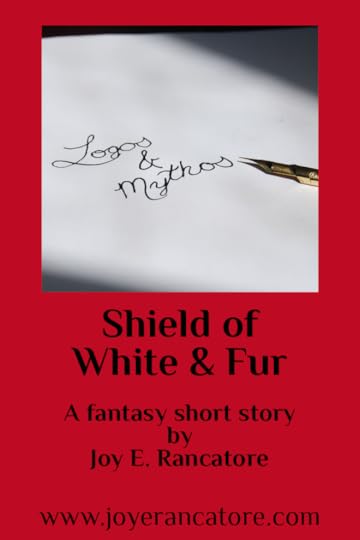
If you’ve followed me for a while, you know that part of Elspeth’s story appears in The Crux Anthology. If you enjoyed this story, please head over to my site to read the entire Tales of the Faerie Shepherds series .
This month’s story flowed from the inspiration of a delightful monthly online writing prompt, #BlogBattle. As you will read on their site, “Blog Battle is a monthly writing prompt meant to inspire writers and entertain readers.” To read several outstanding stories inspired by September’s prompt, “Shield,” head on over to the BlogBattlers site!
You may just find a new favorite author to follow!
For more detailed weekly updates on my writing process behind this short story as well as my other works, please subscribe to my newsletter!

The post Shield of White and Fur appeared first on Joy E. Rancatore.
September 11, 2019
What Is Southern Fiction?
Last month, I had the opportunity to attend a southern (US) fiction panel at my favorite annual event—the Mississippi Book Festival. I missed the first few minutes of that panel.
(In my defense, I was meeting Ann Patchett and handing her a copy of my novel—and might have been slightly fangirling. Don’t ask me what I said; the only thing I can tell you is, likely nothing intelligent. Also, don’t ruin my happiness; I realize she’ll never read it. It’s enough for me to know she touched it.)
From what I understand, I missed an interesting attempt at defining southern fiction. As my friends and I were discussing it afterward, I jumped to a reaction of “How can they not define it; they wrote it?” To which my friend asked, “Yeah. So, how would you define it? You wrote a southern fiction novel.”
I quickly said, “Oh, well, of course, it’s umm; well, you know, it’s really …” Or something slightly less smart. Actually, I mentioned a few aspects—religion, food; welcoming in a stranger with open arms, no questions asked. But, the question lingered. I mean, I wrote a novel set in the South and labeled it as southern fiction. I should know this, right?
Time to Research
Since then, I’ve been pondering the question with this post in mind. So, like every good writer, I thought and thought … and started researching three days ago. It all worked out fine, though, because the research didn’t take long. Turns out, there was one common answer for this question—we ain’t got a clue, honey.
From the perspective of an English major at a southern college, I can tell you that southern fiction has been often banned, frequently condemned and regularly critiqued. And, I’ve always felt like there should be much more to it than controversy, doggone it.
As I was hunting around online, I stumbled upon one article and one post that really stood out from the (not many) others I found. Leah Price wrote a thoughtful piece for the Daily Press in Virginia Beach in 2015, and her title sums it up: “There’s no one way to define Southern fiction.” I think that might just be the key to understanding the genre. What struck you about Flannery O’Connor’s “A Good Man Is Hard to Find” will not be what struck me; same with William Faulkner’s The Sound and the Fury and any other quintessential classic southern story. We’ll agree that it’s southern fiction and then we’ll each add our own “because” clauses. The same applies to more recently published southern fiction: Where the Crawdads Sing, Above the Waterfall, The Clearing, Any Good Thing.
Another aspect of the article that struck me was what Henrietta Ford, an author interviewed for the piece, had to say about the need to make a distinction for southern cultural norms. This was the same conclusion I came to that led to my use of the label “southern fiction.” I had an early reader who’s not from the south let me know that every interaction in my book was weird and unbelievable. Definitely southern then! This is why we have this genre to itself. In each of the books and stories I have mentioned, certain events or interactions or details just don’t make sense to someone who’s never encountered the unique culture and people of the southern United States.
Meredith Borders, in a 2012 LitReactor post, “What Makes a Southern Novel?” gives us much more to think about this topic with some fantastic quotes. I think my favorite line of hers, though, was, “Many of [these southern novels] illuminate the notion of home—of wanting to escape home, of returning home, of the idea that home never truly leaves us, no matter where we may ramble.” While southern stories might originate in the South, the characters often journey to other parts of the nation or world. They retain their innate “southernness” as they do, even if they sure as shootin’ try to shed it. The South seems to have something about it—maybe something in the soil—that gets in, deep under the skin, and hangs on.
Over to You
So, I’m posing this question to you, dear reader friends. What is southern fiction? Go ahead, answer in the comments below. Don’t worry; there’s no stupid answer. Did you not read the part about how no one has a definition? That includes experts in the literary field. I really am anxious to hear all your thoughts.
My Turn
For the remainder of this post, I’m putting on my reader hat. This isn’t meant to be a professional answer to the “What is southern fiction?” question. This is simply my reader’s reaction, because at the end of the day, isn’t all reading of literature simply our reaction to another’s written words? That’s what makes stories live on, longer than their authors will.
So, when I reflected on the southern fiction I’ve read, I realized I always came away not just feeling—though, my goodness, did I feel!!—but I came away seeing, tasting, hearing and smelling. To read southern fiction is to be immersed in the South and all it contains. It’s the roughness of the bumpy shells, the satisfying Ziiiip! of the opening and the silky soft coolness within that makes up the pea-shelling process. It’s the long evenings in the dying light where the nighttime lingers just a little longer beneath the horizon cause folks on the porch want to soak in just a bit more of that purty sunset. It’s to taste the glory that’s slow-cooked in a hand-made batch of dumplin’s. It’s to smell the honeysuckles on the vines and taste that worthwhile teensy drop at the end of the little filament within it. Pull it out just so, and it’s like finding a tiny drip of gold. It’s the sight of fresh-turned earth—and the glorious smell that accompanies it—and the slight rustle in the trees above as the mischievous squirrels skitter, plotting their conquest of the scrumptious goods that will soon push their way up from beneath the rows. It’s the little spray from the kernels when you sink into the first bite of sweet corn for the season.
It settles deeper than the senses and goes far beyond the many, many colloquialisms. Southern fiction encompasses the heart, soul and spirit.
Religion—love, hate or shake-your-fist-at—sits at the center of southern culture. So does family and friendship and love and standing up against all odds. It’s all part of who we are. It’s been part of us from the womb. Every bit of it is ingrained in us.
We can move away and live away for decades. It’s still stuck in the fiber of our being. Don’t believe me? Read Ann Pancake’s Strange As This Weather Has Been. One of the characters that features in the story moved away from the mountains of West Virginia many years before, but came back to visit his mother. As the opening of one of the chapters explains, “Mrs. Taylor’s boy Avery looks like city, but he talks like home.” Regardless of how long you’ve been away, go home, and the accent comes out and the respect for your elders resurfaces. You’ll find yourself grinning at field peas fresh from the garden and shaking away worms without a care while shucking corn. Your memaw will ask if you want some more cornbread to soak up those greens. You’ll smile and say, “Yes ma’am; I reckon I do.”
Later on the front porch, those sinking sunbeams linger longer. The leaves rustle a little more. A breeze blows, bringing the scent of honeysuckle past your nose. You breath deeply and fill your being with the scents and senses of the South. Nature and land, cities and towns, communities—each of these encompass what the South is as well. It’s our land and our places that are as much characters as the people themselves. We personify them when we speak. Our literature paints their details and makes them rise off the pages. They move us and thrill us and inspire us. They fill us with belonging, place … home.
With that home likely comes a Mawmaw who might seem like all she cares about is fattenin’ you up, but who feels deeper and loves harder and grieves wider than any other person in your life. It’s a home that may not always be peaceful and you may have thought you left it behind for something better, but it still claims you. It’s homecooked meals and hot days in the woods and toe dips in a freezing cold stream with an invisible source.
One thing that grows taller than the corn stalks is pride. Pride in community, in family, in congregation, in the land, in the lineage and in the history.
That history brings shame as well. It’s a history our nation shares. Pride and shame meet in a bowing of the head and a strengthening of the resolve. We remember it—won’t ever forget it—but we will move past it, arm in arm with all brothers and sisters, fighting against the prejudice that remains and intentionally choosing a better way. Family, friends, neighbors—the words string together, like peas on your fork. We are a community, drawn together by place, people, past—we are the South, and southern fiction tells our tales.
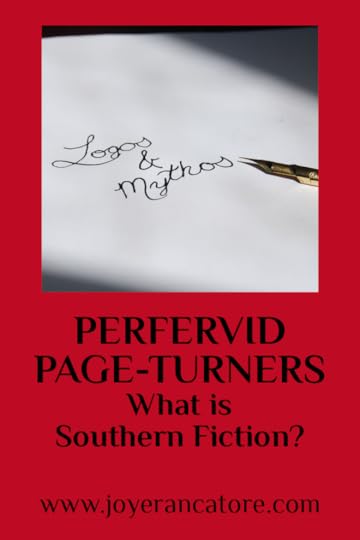
What is southern fiction to you? What do you expect to discover between the covers when you’re promised a southern story? What are some of your favorite southern fiction tales?
Find out more about my southern fiction novel, Any Good Thing .
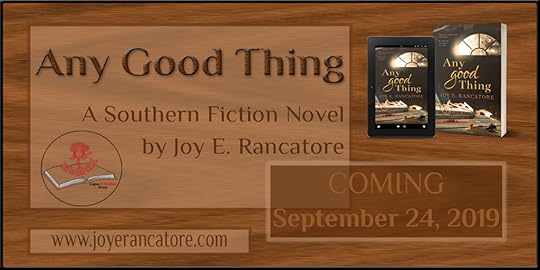

FollowFollowFollowFollowFollow
The post What Is Southern Fiction? appeared first on Joy E. Rancatore.
September 4, 2019
Indie Authors and the Case of Time
I got the question the other day. The one that makes me cringe and frantically glance around for an escape while doing a mental run-through of what the asker’s intentions could be. You know the one.
Are you self-published?
Well, of course I am; and, yes, I chose that path and, doggone it, I’m proud of it, but …
A stigma still lingers with some people when it comes to that word. A remnant still walks amongst us who say the word with a sneer to rival the best 50s TV bully. So, when I get the question, I quickly pull together all I know about that person’s character to determine if they’re curious or a bully. I decided this person most likely fell in that first category, like with a fellow writer’s viewpoint.
Turns out I was right. She’d been considering self-publishing for her own writing. Once again, not an unusual response. The self-pub boom has certainly given many more people the confidence that publication could be possible for them. It feels more attainable, within reach, than the traditional model.
I remember when I used to imagine being published. It was always by a huge company, and the announcement was followed by acclaim and caviar and red carpets. Then I’d wake up in a cold sweat as I realized such lofty positions didn’t have my name on them. Of course, you and I know that glitz and glamour is no author’s reality these days, and we’ve got more options for publishing than you can shake a stick at with all the fantastic smaller and mid-size presses joining the big guns at the literary table.
The Misconception
What surprised and shocked me was this person’s next statement. Though, in retrospect, I don’t know why. It really is the most logical misconception I’ve ever encountered. She gave me her reason for wanting to pursue self-publication.
(And, I paraphrase) I don’t have time to be trying to get published.
She referenced having to contact agents and all with her reason, and I had a flashback to my days of querying magazines. More shuddering. That’s not a process I enjoyed either.
*Continued shuddering*
As I reflected on her reasoning behind considering a self route, part of me wanted to hug her and lead her on a journey of publishing exploration. Another part stood still for a moment and reflected on time as it relates specifically to Indie Authors.
My friend was right that it takes a ton of time to write and prepare a manuscript and query letters and a list of potential agents and/or publishers and all that comes along with that. It’s absolutely exhausting and feels like an impossible feat. Plus, it’s not like you can really draft one email and one letter and be done. Every agent and every company wants something a little bit different. Just like every reviewer. (I just went through that process—EXHAUSTING!)
For the querying process, you have the added emotional toil of wishing and hoping and envisioning … and being crushed. Over and over and over.
So, I get it. I really do. Who’s got time to sit around waiting on responses?
But …
You knew it was coming, right?
If you’re an Indie Author, you’ve probably been screaming at your screen as you’ve read my slow approach back to the whole time concern. Just this week, I have done the jobs of a graphic designer, marketing professional, PR campaign manager, publisher, author, events coordinator, administrative assistant, agent and editor. Those are the jobs for nine different people, in case you lost count. I’ve also celebrated my oldest child’s birthday and kept my family fed and clothed.
Time, you say?
*I’m laughing maniacally right now. It might be the lack of sleep.*
The Reality
Any way you approach publication, you’re looking at a giant investment in time. So, as crazy as I am right now, running on only a few hours of sleep with a list longer than humanly possible to reach the bottom of, why on earth would I recommend this time vortex over the other?
Well, first, this route isn’t for everyone. I just have to get that out there. I feel like the ability to approach Indie publishing with a long-term career mindset requires a slightly different alignment of determination, experience, adaptability and desire to be a constant learner than an approach to traditional publishing does. Not that one is better than the other. They just require different viewpoints, goals and priorities.
Next, what does the self-publishing route offer if time doesn’t seem to be a benefit?
The Indie Advantage
Control
Any time I question my decision, I whisper that little word and stroke it as I would my precious Tolkien Cat. At the end of the day, I might be the one making all the decisions and calling all the shots, but—as tiring and overwhelming as that is—I’m the one who has the final say. I choose my title. I approve my cover design. I keep the deep-rooted elements of Christian faith that I never planned on in my southern fiction novel because that’s the way I was apparently meant to write it, but I also don’t have to label it “Christian fiction.”
To me, control is invaluable.
For me, control means never compromising.
Time
Um, Joy? Haven’t we already established the fact that, if anything, self-publishing might require more time?
True, but time can be rather wibbly-wobbly, my friend. Even away from a special blue box.
Time is a benefit to Indie publishing because I get to set my own timetable. My production schedule is only limited by my own drive and work ethic. I can produce four or five books in a year when I’m my own publisher.
Had I taken the traditional route, by the time I went through the querying process and landed my match-made-in-heaven agent, then re-revised my manuscript to fit what our target companies would be looking for, then went through the submission process (and may or may not have had a few more revisions tossed in there), then went through the contracts and editing and waited for the company’s pre-determined perfect release date for this book, I will—realistically and conservatively—have a dozen books out.
A dozen books that are actively making me money at a higher royalty than I could ever have with an agent and a company behind me. Granted, their marketing reach and influence would be far more broad than mine, so you could logically argue the finances could very well be a wash.
The Summation
Whatever publication route an author takes requires time and comes with pros and cons. Some cons for me might be pros for another writer, and vice versa. With all these considerations in mind, for me, time is on my side as an Indie Author.
I’m off to make the most of it!
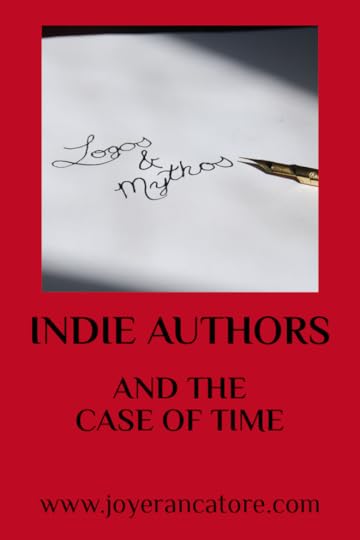
Readers, what questions do you have about the publishing process? I only know much of what I do about publishing because it’s an industry I’ve been studying for decades. Before I seriously considered becoming an author, I gave little thought to how I got the magical portals to other realms that adorned my shelves and graced my nightstand. Except, of course, for romantically envisioning the authors all alone in a peaceful cabin in the woods, surrounded by deer and rabbits and the musical notes of the wind through the trees—or stepping out of their limos to walk into their castles. (Truth bomb: I know hundreds of authors. Neither description fits any of them. My daydreams lied to me!)
Writers, what are your pros and cons for your chosen publishing path? Where does time fall on that list? If you’re still in the deciding process, what questions or concerns do you have? What approach do you find yourself leaning toward? What’s attracting you most to it? And, what’s holding you back from making your final decision?

FollowFollowFollowFollowFollow
The post Indie Authors and the Case of Time appeared first on Joy E. Rancatore.
August 28, 2019
W2H: How to Track Timelines and Characters
We’ve all been there. Mid-way through a novel, we draw a blank on a character’s hair color and realize that secondary character has been pregnant a little too long. So, how can we keep it all straight? I’m sharing what I do as we examine how to track timelines and characters.
As with most writing “advice,” take this as a starting point for your own methods. I will share what I’ve done with four different types of projects. What works for me may drive you crazy. Some of the information I tracked with Any Good Thing may not be necessary for your book. You may prefer Excel over Word or might find index cards a huge nuisance. In other words, here’s what I did; but I want to hear what you end up doing because it will likely be different!
What I Did
Fiction Novel
For Any Good Thing, I had three documents I kept the entire time that saved my tushie. A character guide, a location guide and a timeline. These are all just tables I made in Word because Excel and I don’t get along.
Characters
I included their names, the chapters in which they were introduced, physical characteristics, emotional characteristics, jobs, other quirky aspects, their relationship to the main character, etc. This was also where I quickly jotted notes like “change hair color to red before chapter 20” for Rachael because that was a change I decided on mid-way, and that note enabled me to keep moving forward without stopping the momentum to go back and search for hair references.
Locations
This included things like cities, layout of city blocks (I also drew multiple doodles in notebooks of this) and building details (e.g. Baptist church was red brick; Presbyterian was white wooden). I also included which chapters were set where. This book takes place across eight to ten cities in three states, plus several spots in Iraq. I knew I needed to be careful to keep them all straight and also wanted to make sure I kept the distance between each clear in my mind.
Timeline
SO IMPORTANT! Every scene tied to a particular timeline (whether specifically written out or just a timeframe I, as the author, needed to keep in mind), so I listed them all here. This can include things like pregnancies (gotta remember it takes nine months to get a baby, but no more … we’re not elephants!).
I went a step further and included actual weather details for the location on that day (it actually added some fun challenges to my story in a few places and forced me to include reality in that way—it would have been cold, so they wouldn’t be in sleeveless attire or there were thunderstorms that day, so the thunder and lightning add to the intensity of this important scene). I use Weather Underground to do this research.
For this book, I framed my entire timeline around Jack’s time in the Marine Corps. I talked in depth with my brother about how long each promotion would take for him (which played into his opportunities, tasks, getting into Scout Sniper, etc.) I knew when I wanted him to be in Iraq as well, so that all played into it. I was able to work backward and then weave in all the events as I wrote them.
Short Stories
For some of my short stories, I actually write my timeline out on index cards and pin them to a science display board. I honestly prefer that because it’s something tangible that I can pick up and move, but trying to do that for a full novel is a whole lotta index cards! One day when I have my own giant library/office (HA!), I’ll have a full blank wall where I can timeline to my heart’s content.
We all need dreams, right?
I write details of each scene on cards and then put them in order. I like to use colored cards to keep up with character or setting details, quotes or lines that come to me and research. Another way I use notecards is to jot down questions I have that will require research. That way, I can keep writing and then take the cards and jot down answers once I have time to look them up.
Narrative Nonfiction
When I wrote the narrative nonfiction book that was my first full-length project, I used a combination of tables, notebooks, notecards and project boards. Because the subject matter required a great deal of research on medical details and rehabilitation, some of my notecards held bibliographical information; others numbered quotes or notes to correspond with the source from which they came.
I had a full plastic container full of cards with Ashlee’s timeline as well. I pulled all those details from journals kept by her parents, as well as from her own diaries, accounts from friends and an online journal/log kept while Ashlee recovered. Once I mapped out the timeline into an outline for the book’s chapters, I pulled those notecards and pinned them to a board under the appropriate chapter heading.
My daughter helped me make them pretty, so that was a fun way to include her!
Multi-series Fantasy with World-building
Now, this is a project I’m in the very early stages of developing. You might know I had a fantasy short story published last fall in The Crux Anthology. “Ealiverel Awakened” will be a small part of a much larger series of books surrounding my main character, Elspeth, a faerie shepherdess. You might also know that I write super short stories set in this same world—most about other characters—almost every month, as part of the BlogBattlers prompt challenge. These Tales of the Faerie Shepherds will eventually come together to form another related series of fantasy books.
As I research creatures and faerie lore for these stories, I’m keeping detailed notes with links to sources and such. As I write, I’m keeping up with the language I’m developing by copying every line (along with its translation) into one document and trying to keep up with my sources for various words. Plus, I have some details about plants and such that are specific to my world.
I’ve also kept some details on characters, including the origins of their names and their roles in the stories as a whole, their powers and more. This will be a massive project, so I’m sure I’ll be utilizing all the tools I’ve used previously once I dive deeper into the process. For now, I’m just taking monthly dips into the world and doing my best to document the details when I do.
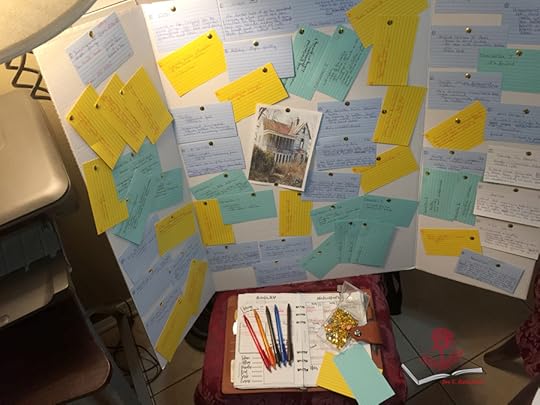
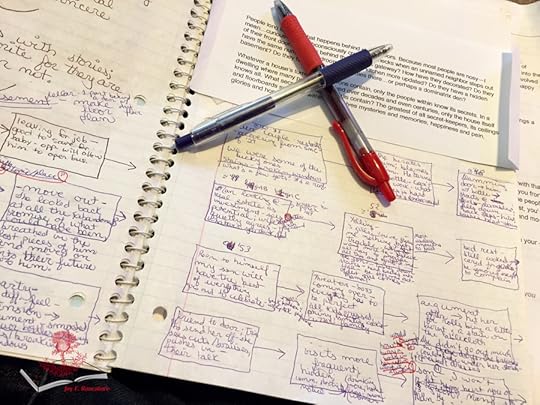
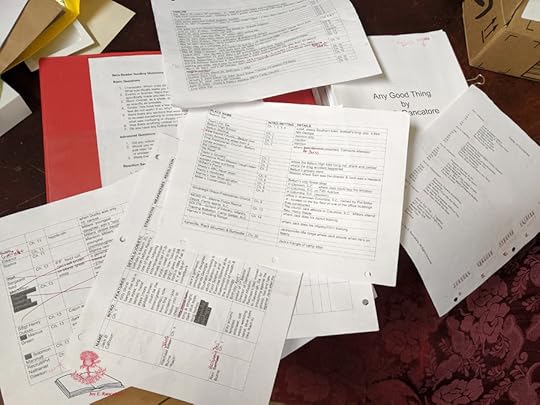
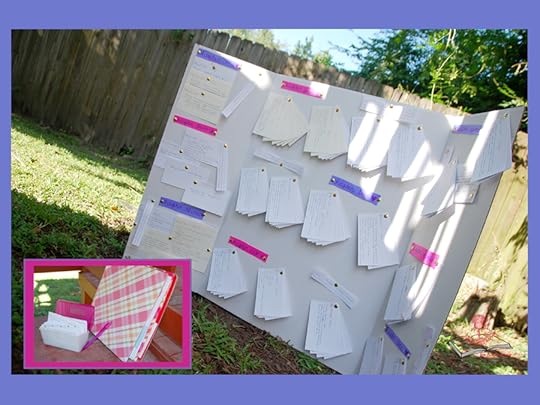
Why I Did It
Early on I learned that I need to be meticulous with keeping up with my research sources and the details I create about characters, settings, etc. My primary reason for this is, I don’t sit down and work on one project at a time start to finish with no interruptions or without having to work on other projects at the same time. And, let’s face it, my brain’s just not big enough to juggle it all!
I use Word documents for the tables and notes because I can save them to the cloud and access them wherever I am from either computer I have. I can also print them out so I can edit and mark them up with my favorite red pen as I think through the details of my stories and their characters.
The notecards really are my favorite thing, though they’re not always the most practical and can be time-consuming to make. When they make sense to use, you better believe I will use them. The best aspect about them for me is the ability to line them up, spread them out and move them all around.
Now, I will mention that Scrivener has a built-in digital notecard feature, which is super cool! I would like to play around with that more and see if I can make them work, especially for my longer projects.
How It Worked
I’ve been pleased with the process I’ve developed for myself, though I’m sure I’ll be tweaking and adjusting it over the years and project-by-project. The biggest thing I’ve learned to watch out for is spending too much time putting the cards together or trying to make it all look “pretty.” Trust me—your process doesn’t need to look good; it needs to be effective, efficient and evolving. The purpose behind this is to help during the revision and editing stages and to help you keep moving (e.g. question cards).
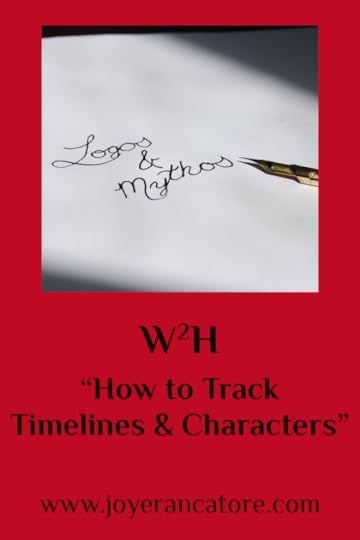
Now that I’ve shared my process, I’d like to know yours! Tell us how you track your story’s timeline and characters. What other details do you like to keep track of as you write? Do you prefer keeping up with these things digitally or with pen in hand?
It is my desire that every post has something for everyone. Even if I’m writing for other writers, I try to include takeaway value for my faithful readers, too. If you ever have questions or suggestions for me, please drop me a line. I love to hear from you!

FollowFollowFollowFollowFollow
The post W2H: How to Track Timelines and Characters appeared first on Joy E. Rancatore.
August 21, 2019
A Day in the Life of an Indie Author: Flexibility
Welcome to our first official “Day in the Life of an Indie Author” post. Last month, I gave you an introduction and shared why I chose the Indie path and what some of my roles are. Now it’s time to dive in and let you guys behind the scenes.
As is often the case with these things, a theme emerged during the past month. That theme was “flexibility.” While that could be the focus every month, if we’re being honest, it became especially important this month when our air conditioning went out.
Nothing Says “Flexibility” Like the Heat’s Melting Power
If you don’t have the pleasure of living in southeast Louisiana, allow me to share a little about the weather here. In July and August, the sun overheats. When it does this, it bends down over the southern United States, and all its sweat trickles down into the atmosphere where it hangs like a moist molten lava shroud that we breathe choke in. The drops that get through land on the concrete and asphalt and, after sizzling, rise up as steam that’s as thick and powerful as the largest anaconda you can envision. It then wraps its way up around us and squeezes that choking air back out.
Aside from the heat, it’s really quite lovely. You should come visit!
Now that you have a better understanding of our temperatures, let’s get back to the story at hand. No air conditioning. I realize this is such a selfish first–world problem. I also understand that it hasn’t been all that many decades ago when there was no such thing as AC here. But, I’m willing to admit I’m a big, fat wimp. It was HOT! We looked like a family of Lumières—you know, the candelabra from Beauty and the Beast?—our faces were literally dripping off. (Unfortunately, no wrinkles were lost in the process.)
As you can probably imagine, dripping face + keyboard ≠ productive workflow (or a happy keyboard). Thankfully we were able to stay with my in-laws, whose air worked just fine. On the flip side, though, they have no Wi–Fi. So, what’s a girl with a weekly blog and podcast, daily social media presence and a book in the process of being uploaded to distribution channels to do? Be flexible!
Flexibility Doesn’t Come Naturally
I wish I could tell you flexibility was no big deal and that I’m great at it; that I’m breezy and flowy and easily adapt to every change in schedule. No, friends. I love schedules and consistency and blocks of time and knowing what a day will hold before it begins.
Alas! I married a man who’s never worked an 8-to-5 job (he has had multiple crazy-hour jobs at once, though). I have worked as a freelancer for twelve years now and have two kids and a menagerie of animals to boot. I also live in a place where we frequently lose power (like, at least once or twice a week and usually when I’m under the gun to get a task completed) and in a house where we desperately need a new air conditioning unit. Looking at my desired schedule is like gazing in the window at Tiffany’s. It looks lovely and shines brightly, but that gorgeous tiny blue bag may as well be on Mars for all the chance I have of reaching one.
So, when the cool air went the way of the dodo bird, I prioritized. What’s got to get done? What do I have to do on my computer at home? What can I do on my laptop without Wi–Fi? What can I accomplish without any modern tools?
I whipped through tasks online while my sweat sweated at my house and then headed to cooler quarters for everything else. It all got done, and we were able to patch up our limping unit again—hopefully until next spring. Fingers crossed!
Juggling Various Tasks Calls for Daily Flexibility
While that was an extreme example of the need for flexibility in my job as an Indie Author, every day requires some improvisation. This past month, I finished formatting and uploading all the files for my novel, edited a client’s manuscript and completed another client’s job, worked on revisions for a nonfiction book I co-wrote, started preparing some marketing plans for the novel and contacted many booksellers and reviewers. On top of those things, I did my first interview with a local news outlet and kept up with weekly blogging and podcasts and newsletters and all the other daily communication that comes with the job. My kids haven’t starved or completely run out of clothes (despite my daughter’s dramatic groans of nothing to wear), and I managed to clean out my incredibly junky bedroom. Good news! We still have a floor in there!
Presenting: A Typical Day of Flexibility
But, Joy, what about a DAY in your life? Isn’t that supposed to be the subject of this long-winded post? What does an actual DAY look like for you?
Never fear! I’m going to give you a moment-by-moment recap of one of my days this past month. Ready? Here’s how my day went on July 18:
Started uploading raw podcast episodes to OneDrive to make more space on my external hard drive (in case you’re wondering, that takes a while because those files are HUGE!)
Checked emails
Updated this log
Perused the Realm Makers site—longed to be there (Can you tell I’m procrasti-surfing?)
Commented with a link to my monthly short story on the #BlogBattle site
Sniffed the pork cooking low and slow in the oven
Salivated
Counted the minutes until supper time
Cast myself into the pits of despair [Whether this was over the time until supper, not being at Realm Makers or something else entirely, I cannot recall.]
Tried to find an e–book that vanished from my Kindle [By the way, I discovered a whole bunch of hidden folders a couple weeks later; so, if you’re having issues with books disappearing on your Kindle, I can help!]
Discovered Ann Patchett will be at the MS Book Festival ; texted Mea Smith (actual word used was “Gamechanger!”); perused Ann Patchett’s Goodreads page and re-read my review of Bel Canto
Got an email from a client needing an image correction; handled that; sent an invoice
Reviewed our podcast outlines and looked over our nonfiction work-in-progress
Read through a speaker application again and thought about some potential topic proposals to help us stand out
Updated the “Tales of the Faerie Shepherds” page on my website and started updating my home page
Received frantic emails from a client; found all was well; calmed client
Kids got their own lunch—isn’t that nice? Maybe they’re maturing after all!
Cleaned spaghetti sauce from all over the kitchen floor, the stove and the cabinet doors
Lost my cool
Received more frantic client emails (FYI: browser refresh works wonders!)
Pulled apart the pork shoulder for tonight’s sandwiches—and sampled as I worked
More home page updates (previously interrupted mid-word by the sauce fiasco)
Third cup of coffee and a bag of CHEETOS®—see, I eat
Completed the website updates I’d planned for today, plus a few more!
Talked to my sister on the phone
Got a shower—finally
More site updates
Prepped supper
Dried hair
Finished prepping supper; waited for Tony to finish his phone conversation
Updated my to-do list—finished today’s and planned an update to tomorrow’s
Poured wine
Ate supper
Family devotions
Did hair/makeup
Straightened up and set up equipment; opened Skype
Checked emails
Podcast time ! Recorded three episodes; planned speaking submission and book festival; discussed book revisions, marketing and further details
Headed to bed around 1:30/2; read 70 pages until I finally got tired enough to sleep
And that, my friends, is a rather typical Day in the Life of This Indie Author!
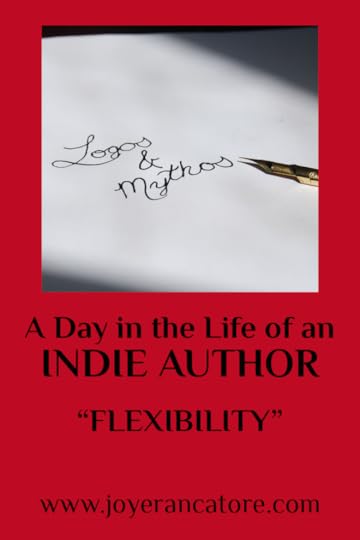
What questions do you have about this crazy business of mine? What would you like to know about the life of an author? Are you excited about this series?
It is my desire that every post has something for everyone. Even if I’m writing for other writers, I try to include takeaway value for my faithful readers, too. If you ever have questions or suggestions for me, please drop me a line. I love to hear from you! To make sure you never miss a post—and to receive other weekly extras, like reading tips and writing tips, occasional exclusives and various freebies, including a few for subscribing—join my Fellowship of newsletter subscribers today. Just click the big red link!

FollowFollowFollowFollowFollow
The post A Day in the Life of an Indie Author: Flexibility appeared first on Joy E. Rancatore.
August 14, 2019
Feathersong in the Aerie
This story continues a series of short fiction exploring some of the Faerie Shepherds and Shepherdesses within my fantasy world. Read below the story for further explanation and head over to the Tales of the Faerie Shepherds if you’d like to read more!
High atop the peak, rose a resolute aerie. Hidden within, Elsu bowed his head. Unrest filled him as he tuned in to the pain and fear nature revealed. Few men would be allowed inside an eagle’s nest, but Elsu was no mere man. Faerie Shepherd of Nature and Feathered Creatures, he had long listened to the shifting in the earth beneath him, the rustling of feather-tips all around and the whispers rising in the trees and rocks.
Tonight, whispered dirges drifted on the wind where joyful chatterings had played mere hours before. The promised chosen had arrived, delivered at the perfect time. Maelphaeus quelled all celebratory sounds, though, as he took this occasion to unleash his Daemons across the realms. Their chains unbound, or at least loosened, the degenerate creatures spread terror in their wake.
Elsu felt each beat of the earth’s mourning complaint through his bare feet as its trembling ebbed and flowed beneath them. The wind rose, wrapping him in its urgent pleas as it caressed the long black hair that usually hung in braids, clinging securely to his waist. The brown runes across his dark chest began to twirl and dance; his hair waved against the wind, directing it and driving its movements. As the tattooed markings took their leave of Elsu’s chest to dance around the Shepherd, he lifted his head toward the heavens. Two golden beams of light shone forth as he opened his eyes. Arms outstretched, hands uplifted, Elsu called out,
Unisomuntia; unisomuntia, Dhae. Gun ta mi toren ei ventis quattuoris. Voíthetia mi fleigh.
A golden shimmer remained around his sparrow-brown eyes as Elsu scaled the aerie’s wall. Music—a swooshing sound—met him, and he joined in with a chanting duet. In the Feathersong of the Eagles, Elsu called out his charge to intercept Maelphaeus’ demonic hordes.
Arms outstretched, Elsu soared.
“ Feathersong in the Aerie” Copyright © 2019 by Joy E. Rancatore. All Rights Reserved.
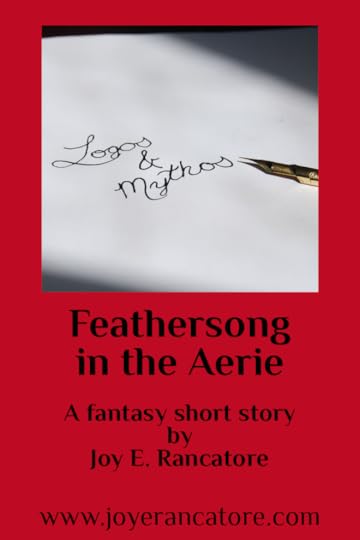
What do you think about this world of mine that I’m building? Elsu first appeared in “Beneath the Green Corn Moon.” If you enjoyed this story, please head over to my site to read the entire Tales of the Faerie Shepherds series .
This month’s story flowed from the inspiration of a delightful monthly online writing prompt, #BlogBattle. As you will read on their site, “Blog Battle is a monthly writing prompt meant to inspire writers and entertain readers.” To read several outstanding stories inspired by August’s prompt, “Intercept,” head on over to the BlogBattlers site!
You may just find a new favorite author to follow!
For more detailed weekly updates on my writing process behind this short story as well as my other works, please subscribe to my newsletter!

The post Feathersong in the Aerie appeared first on Joy E. Rancatore.
August 7, 2019
All About Books and Reading
In an attempt to be more organized and serve you better, I decided to set specific topics for each week of the month. This is our first reader-specific post and will be a summer recap and book launch update. I have so many topics I look forward to writing about during these posts, and I hope you will interact with me as we plow ahead. I’ll end each of these posts with some reading-related links I think you’ll enjoy and a question and/or a challenge. Today, I’ve got one of each of those for you and eagerly await your responses!
Behind the Scenes of a Book Cover
If you subscribe to my weekly newsletter, you received my cover reveal a full week ago. If you follow me on social media, you got your first glimpse either Monday night during my monthly Logos & Mythos Book Club LIVE or on Tuesday when I started blasting the images everywhere. I didn’t want my own site to feel left out, though, so here is a look at both the front cover and the full layout that you’ll see on my paperback.
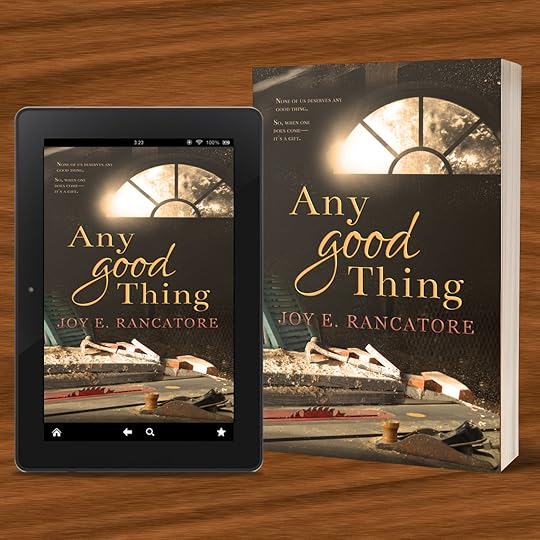
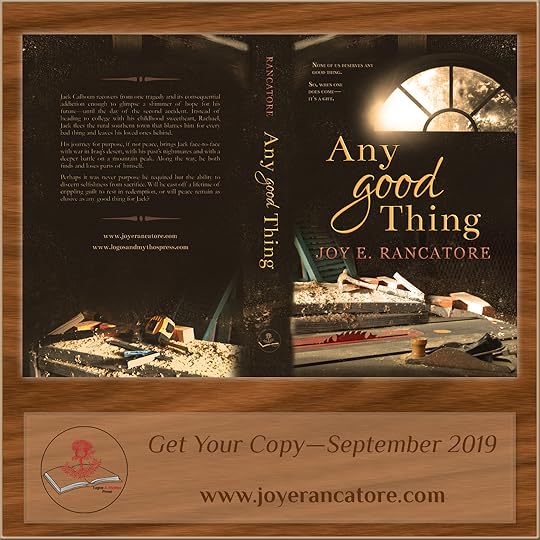
This gorgeous cover comes from the incredibly talented Rachael Ritchey. I am thankful for her creative genius, attention to detail and patience with me. From the very first mockup, Rachael really nailed exactly what I desired for Any Good Thing, but her creativity went so far past my imagination. I sent her a few photos I snapped of some tools in my father-in-law’s workshop for inspiration, and she was able to use some of them in that first round. She encouraged me to take more, and most of the imagery in the cover comes from those photos. I had help from my father-in-law and husband in choosing the right tools and with sprinkling shimmers of sawdust. One of my dear friends let me borrow her camera baby when mine wasn’t behaving.
I think one of the best unexpected results of being an Indie Author is the opportunity to work alongside friends and family and to have professional contacts become friends as we team up.
Any Good Thing will be available wherever you purchase books in late September 2019. Here is the book’s description to give you a little taste of what you’ll find inside this stunning cover.
Witness a young man’s battles of mind, heart and soul and follow his coming-of-age journey from selfishness to true sacrifice and from recklessness toward redemption in this contemporary southern fiction novel meant to reside on your heart’s bookshelves.
Jack Calhoun recovers from one tragedy and its consequential addiction enough to glimpse a shimmer of hope for his future—until the day of the second accident. Instead of heading to college with his childhood sweetheart, Rachael, Jack flees the rural southern town that blames him for every bad thing and leaves his loved ones behind.
His journey for purpose, if not peace, brings Jack face-to-face with war in Iraq’s desert, with his past’s nightmares and with a deeper battle on a mountain peak. Along the way, he both finds and loses parts of himself.
Perhaps it was never purpose he required but the ability to discern selfishness from sacrifice. Will he cast off a lifetime of crippling guilt to rest in redemption, or will peace remain as elusive as any good thing for Jack?
This book lends itself to a lively book club discussion or shared read between couples and friends. While readers who remember 9-11 will have an instant bond with the story, anyone who enjoys a well-paced tale full of larger-than-life characters—with a dash of southern charm and a whole batch of tasty food—may just discover a new favorite book in Any Good Thing.
Summer Reading, Anyone?
Since the beginning of June, I have hosted a special Summer Reading Challenge on my Facebook page in connection with my Logos & Mythos Book Club. Students in some parts of the country might be returning to school, but we’ve got another month of summer reading fun ahead!
On September 2—during my monthly LIVE Book Club on my Facebook page—I will announce the two winners for the summer. One winner will be the reader who has completed the most books in our challenge (eight categories to choose from!), and the second winner will be the follower with the most points earned over the summer. Points come from participating in events (like the monthly Book Club), sharing posts, commenting on and interacting with posts and sharing book reviews with other readers. It’s all pretty simple! You read and hang out on my Facebook page, and I’ll award two lucky folks with a paperback copy of Any Good Thing and some other goodies!
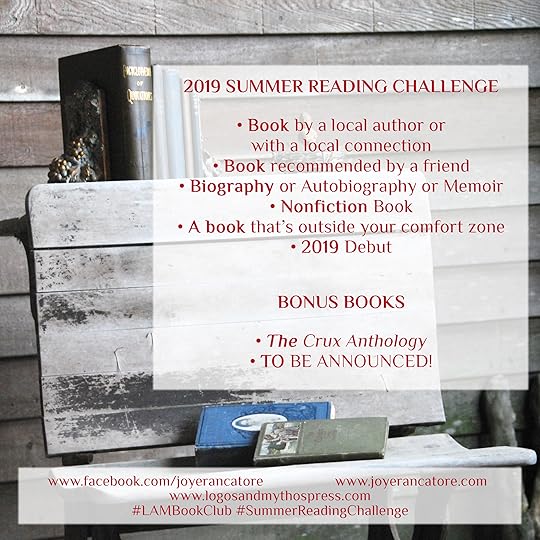

You might notice the second bonus book category is Any Good Thing. So, if you choose to participate in that one, I will send you an ebook version before it’s even available! Just email or message me that you want a copy and what kind of e-reader you have.
“Why a reading challenge?” you might ask. Well, everyone loves a good challenge, right? Plus, it’s an opportunity to send some goodies to the winners. More than anything, though, it’s an opportunity for us to come together over our common love of literature, share what we’re reading, push ourselves out of our comfort zones and discover new ways every reader can interact with books and their authors and become better patrons of literature.
So, come join us! You’ve still got plenty of time to jump into the mix!
It’s Festival Time!
I live near New Orleans; and, if there’s one thing I’ve learned while living here, it’s that you can’t beat a good festival! The very best kind of festival for me, though, is a Book Festival! We’ve got an outstanding one coming up.
On August 17, 2019, readers and writers will converge on the state capitol in Jackson, Mississippi, for the Mississippi Book Festival. Friends, this event is extremely special to me and my writing bestie, Mea Smith. This is the fifth year of the Festival and our fourth to attend. In 2016, it’s where we finally found the inspiration and motivation to follow our dreams and began to find our voice in the literary world. When we walked onto those blocked-off streets, Mea and I breathed deeply and sighed our contentment in the realization that we were home among our people—patrons of literature.
If you love literature and you’re within driving distance, you should join us at the Literary Lawn Party! Mea and I will be there, and I’d love to say “hello” in person!
Joy’s Reading-Related Links Recommendations
If you’d like to follow a book blogger who gives helpful, well-rounded reviews and makes great reading lists, check out Allison with Mind Joggle. Here is her August 2019 Reading List .
If you love Anne of Green Gables as much as the rest of us, Elsie over at Tea & Ink Society has an outstanding post titled, “ The Ultimate Guide to Anne of Green Gables Film Adaptations .”
Now, this article is a longer read that I would love for you all to take the time for. Scott Semegran presents his case that “ The Future of Literary Fiction is Self-Publishing .” Friends, this post touches my heart on a number of levels.
First, I happen to love literary fiction. I mean, I did write a literary fiction novel, after all! Unfortunately, these days many readers crinkle their noses at the term; primarily because they’re not sure what it means and perhaps because some authors have used it to drone on without plot or form. True, it is a genre without specific rules common amongst other categories; but it offers so much range and possibility in its typical focus on the human condition. It can be one of the absolute best genres in which to learn something about ourselves and our fellow humans.
Second, Scott shines the spotlight on the tremendous value in and quality of many self-published authors and even highlights several Indie Authors who have written literary fiction. You all know how passionate I am about this path I’ve chosen , so it’s no surprise I appreciated his take on the rise in professional self-published authors.
Third, he gives a proper nod to another part of the literary community I adore—local independent bookstores. Reader friends, our Indie bookstores are on the rise and have boosted literary community across the United States. As Scott points out, this seems rather improbable in our age of instant downloads and cheaper options at the click of a mouse; however, the people have spoken: we want a book community, not a vague, somewhere-out-there book cloud. We want to walk into a store that brings events with authors and other artists into our community and gives us personalized recommendations from store owners who are not only fellow readers, but who know our name and our reading preferences. As we say around my part of the country, “Geaux Local!”
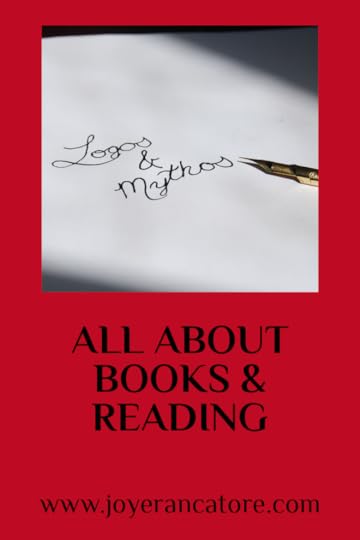
QUESTION: Have you ever attended an event where an author signed, read from and/or spoke about his or her book? What were your favorite things about that event? What would make you attend or encourage you to detour to an author’s table in a larger store (candy, book swag like bookmarks, giveaway, etc.)? What did you enjoy most about whatever event you attended? If you’ve been to several, do you prefer a simple signing, a reading or a presentation of some sort by the author (behind-the-scenes details about the book or a talk about something book-related)?
CHALLENGE: Did you know you can have Any Good Thing in your local independent bookstore or library? That’s right! All you have to do is let them know and put in an order (store) or a request (library). Your local bookstore can order any book with an ISBN (the special number assigned to a book). Most libraries welcome requests from their patrons. If you would like to do this, please email me because I have a sheet all ready for you with all of the information (including ISBNs) they will need from you. I’m also willing to do in-person book signings and can do in-person or virtual book readings or talks about the facts behind my fiction. These options could also extend to book clubs who choose to read my book together. For more information on booking me, please contact Logos & Mythos Press!

FollowFollowFollowFollowFollow
The post All About Books and Reading appeared first on Joy E. Rancatore.



